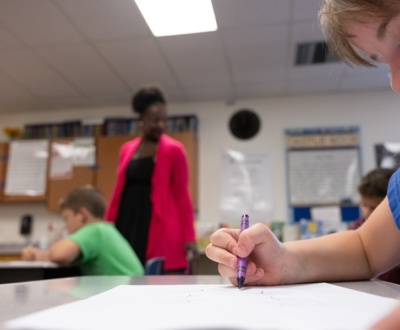For those of us who have worked in education for a long time, we see pendulums swing back and forth. The big push toward standards based grades in the early 2000s has received recent pushback as teachers — overwhelmed with the impacts of the pandemic on student learning, highly-politicized educational debates, and increased teacher turnover — cannot possibly handle “one more thing.”
The transition to standards based grading is much more than another item on a to-do list. Implemented well, it is a monumental shift in how leaders, teachers, parents, and most importantly, students themselves, understand learning. Implemented poorly, it is just traditional grading “rebranded”, with the same problems, but a 0-4 point scale instead of letter grades.
Why is it so important to get the transition to standards based grades right?
Education is culture. We may think of culture as the music, cuisine, and language(s) of a group of people or society. A larger definition includes the beliefs, values, and institutions that one generation passes down to the next. Ingrained within our educational systems in the US are so many of the skills, concepts, and values we wish to instill in our children.
Attitudes and beliefs about grading are also a reflection of our cultural understanding of what skills and concepts students should master during their studies. Traditional based grading methodologies incentivize student work. This is a reflection of how we, as Americans, value hard work as a key life skill. They are imperfect measures of student learning. In traditional grading, learning is a part of, but not the central focus, of grading policies.
Unfortunately, grading is also the aspect of teachers’ work that has some of the least direction and is the most subject to cultural norms around grading. Most teacher training programs do not include training on reliable, valid methods of assessment and grading, and schools themselves often lack a unified grading policy for teachers. Teachers are left to devise their own grading policies; and in the absence of district curricula, the measures and assessments to evaluate learning. As a result, grading policies are highly inconsistent classroom to classroom. Inconsistencies can also make the grading policies of individual teachers seem highly subjective and biased, especially when they are blending aspects of student learning with student work habits in ways that are highly variable.
The standards based vision embraces grades as a snapshot of student learning. Without a concentrated effort to move toward that vision, the dominating culture around grading will persist. Teachers will default to the ways that they were graded as students. Parents also default to the traditional grading paradigms they are also familiar with. But familiarity does not mean that these systems are good systems.
F is for Failure
Many educators know that there are deeply entrenched inequities in public education. The US population is more diverse than ever, but US schools are still segregated. And according to the Georgetown Center on Education and the Workforce (CEW), being born wealthy is a better indicator of adult success in the U.S. than academic performance.
The pandemic has made these inequities even more visible. The living conditions, technology, and educational resources that were/n’t available had a profound impact on learning.
The way that educators judge the quality of a student’s performance at school, grading, has profound impact on that student. Grading can exacerbate biases already present in our educational systems. In particular, racial and class bias lead to biased evaluations of student work. This can then impact students’ future learning and academic trajectories. At scale, the cost of ignoring unfair and inequitable grading practices means widening the gaps between different outcomes of students after they leave the classroom.
Two or three times a year, teachers rush to prepare reports on student performance. What they share can have profound consequences for how students see themselves as learners. For those that struggle with certain concepts and ideas, failing grades make a student feel like a failure. They are not motivating. In fact, they can destroy a student’s motivation.
F is for First Attempt in Learning
Language is such a critical piece of the transition to standards based grades. The way we describe learners and their progression reflects how we as educators feel about the learning process and our learners.
In standards based grading language, if a student did not turn in work? No evidence of learning. A student is not performing well? S/he needs support. Rather than subject-area letter grades, students have a list of specific grade-level expectations. No longer is a student a “C student in reading” or “getting a D in math”. Instead, s/he needs to work on “recounting a story and identifying the primary message of the story” or “addition and subtraction within 20”.
In a standards based grading system, grades offer highly specific feedback and recommendations for students, rather than labels.
Reporting Out Behavior
The traditional grading system incentivizes work whereas the standards-based system incentivizes actual learning. As a consequence, the most common push-back from teachers is that standards based grading systems remove accountability from students. Students with lax or poor work habits can submit late or sloppy work and no longer have to invest time to study for tests. This is because they will be given opportunities to retake and redo work, and specific to tests, can preview test topics and study accordingly rather than adequately reviewing in advance the first time.
Rather than completely eliminate incentives for work, many teachers employ grading practices in the gray area between traditional and standard-based grading. To keep grades in a standards-based system focused on learning, however, report out on behavior, also. Teachers can continue to hold students accountable for late or missing work and other behaviors they wish to share with students and parents, including how students respect classmates, adults, and act responsibly and safely at school. However, this information should be reported out separately from learning performance.
The Mind-Shift Toward Standards-Based Grades
The switch to standards-based grading is not like flipping a switch. It is a process. Report cards will change, but there is a bigger, mindset shift that goes well beyond report cards. The work to change attitudes about what is important to assess for, grade, and share with families is the great challenge. This is more important than changing an A to a 4. The potential of the standards-based movement goes beyond the minutes of the report card committee or school board meeting. As we change the educational culture around the purpose of grades to focus on learning, we help students, teachers, and families focus on learning as a process. We also embrace that we can all, struggling or not, grow as learners.
If the shift to standards-based grades in your district is not happening as quickly as you thought it would, do not be surprised. As with any work that is really meaningful and worth doing, it will not be easy and it will take time. Teachers need ongoing support, the proper tools to support the change, and time. If you wish to see our own tools to support your schools in the transition to standards based grading, check out this article or a quick, 3-minute explainer video here.
Citation
O’Connor, K. (2009). How to grade for learning, K-12 (3rd ed.). Thousand Oaks, CA: Corwin.
About us and this blog
Our team and tools help schools implement standards-based grading, streamline assessment systems, and use meaningful data to drive decision-making.
Interested in Learning More?
Download our free Educator's Guide to Standards-Based Grading to access a roadmap to improve standards-based grading systems in your schools.
More from our blog
See all postsForefront is the only assessment data solution optimized for classroom assessment results, leveraging these results to fuel instruction, PLCs, and grading. Elevate meaningful assessment data district-wide to transform how you understand and communicate about student learning across your schools.
Copyright © 2025 Forefront Education, Inc. All Rights Reserved.








